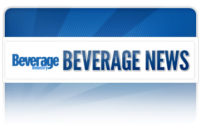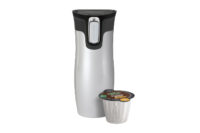99 percent of American households shop the grocery channel
Coffee, spirits dominate channel's beverage sales

Coffee was the strongest beverage performer in the grocery and supermarket channel in the past year, according to IRI’s Susan Viamari. She credits Eight O’Clock’s single-cup offerings with leading some of this growth. (Image courtesy of Keurig Green Mountain Inc.)

In line with health and wellness trends and interest in bottled water, liquid concentrates also are performing well in the grocery and supermarket channel, Willard Bishop's Jackie Gray says. (Images courtesy of BYB Brands Inc.)


When consumers shopped the aisles of different retail channels during the past couple of months as they prepared for the holidays, product assortments and even store environments probably started to seem the same after a while. This is partially because of channel blurring, according to Chicago-based Information Resources Inc.’s (IRI) September/October 2014 Times & Trends report “Channel Migration: The Road to Growth Has Many Lanes.” In fact, today it is more difficult to distinguish between retail formats based on product assortment than it was a few years ago, it reports.
As retail channels change, mass merchandisers and supercenters, warehouse and club stores, and discount retailers have expanded their grocery offerings, competing with the supermarket channel for share, points out David McGoldrick, U.S. analyst at Chicago-based Euromonitor International.
Grocery stores still claim the majority of the larger, pantry-stocking shopping trips at 45 percent, along with mass merchandisers/supercenters and club stores at 31 percent and 33 percent, respectively, according to the IRI report. However, the urban or smaller-store format that is popping up in the mass-merchandise, natural and organic, and dollar retail channels is catering to the on-the-go lifestyles of today’s consumers, the report states. The capability of making smaller, more frequent trips is being met with success, it reports. Drug stores currently claim 54 percent of the quick-trip shopping experiences, and dollar stores claim 46 percent, compared with 25 percent for the grocery channel, according to IRI data.
In spite of these opportunities to steal share from the grocery and supermarket channel, the process is slow, Euromonitor’s McGoldrick says. “Supermarkets themselves are still growing, and they’re still the largest channel,” he says.
Traditional grocery channel sales increased 1 percent to $522.8 billion in 2013, and traditional supermarket sales increased 0.4 percent to $44.2 billion, reports Jackie Gray, director of Barrington, Ill.-based Willard Bishop. By comparison, fresh-format stores experienced sales growth of 10.4 percent, limited-assortment store sales grew 4.1 percent, warehouse store sales were up 3.4 percent, conveniences store sales increased 2.4 percent, and the dollar chain format saw 13.7 percent sales growth in 2013, she reports.
Although the grocery channel appears to have the lowest growth rate by percentage, it actually is growing at a similar rate to the mass-merchandise/ supercenter and warehouse/club channels, Euromonitor’s McGoldrick says. “Supermarkets just have a much larger base, so it’s harder for them to post the same growth in percentage terms,” he explains. “Overall, for the past three years, [the grocery and supermarket channel] has been growing at about between 2 and 3 percent each year. For the past year, it’s been a little bit on the lower end of that, [and] for 2014, we’re projecting about 2 percent growth.”
The 99 percent
Even though consumers now have a plethora of stores to choose from for their grocery shopping needs, the grocery channel claims 99 percent household penetration, IRI reports. This is because the grocery and supermarket channel is the retail channel that consumers think of first when they need to buy groceries, Euromonitor’s McGoldrick says.
This consideration is because of the wider range of food and beverage products the channel can offer, McGoldrick says. “Because they are solely dedicated to foods and grocery items, they can have a wider range of items, they can offer more brands and more variety, whereas other retailers have to be a little more discerning in the brands they’re offering, just because they have to dedicate shelf space to more than just their grocery sections,” he says. “You can get everything [at supermarkets and grocery stores], with all the national brands as well as private-label brands, while [in] the other channels, you can get by [on their product offerings], but they might not have those couple of items that you’re looking for.”
In addition to consumer packaged goods (CPG) products, grocery stores and supermarkets also offer additional services, like meat counters, delis and bakeries, where consumers can pick up fresh items, McGoldrick points out.
Bottled success
Of the products and services offered at grocery stores and supermarkets, non-alcohol and alcohol beverages make up 19.1 percent of the channel’s revenue, according to Los Angeles-based IBISWorld’s August 2014 report “Supermarkets & Grocery Stores in the US.” This makes it the second-biggest contributor to channel revenue, below “other food items,” it reports. This makes sense, given the consumer need to replenish commodity beverages, like milk, often, Euromonitor’s McGoldrick adds.
More specifically, coffee and spirits/liquor are two of the Top 3 growth categories, along with refrigerated meat, within the grocery and supermarket channel, according to IRI’s report.
“The strongest beverage performer during the past year was coffee, which recorded sales of $4.6 billion, an increase of 4.5 percent versus the prior year,” says Susan Viamari, editor of Thought Leadership at IRI. Viamari credits the category’s innovation with boosting its sales. “In [the last few years], three powerful coffee launches hit grocery shelves: Keurig’s Eight O’Clock and Maxwell House Café Collection single-cup lines and Starbucks’ Blonde Roast line. Starbucks also introduced its new Starbucks Refreshers line, which earned more than $30 million across IRI’s multi-outlet geography in its first year.”
Although carbonated soft drink sales were down 2.5 percent in 2013, they still were the most popular beverage category purchased that year in terms of volume sales, according to IBISWorld’s report. And although its consumption rates have fallen, beer followed carbonated soft drinks as the second-most purchased beverage in the channel in 2013, the report states. Wine, which was the third-most popular beverage category, has become more popular because of the widely advertised health benefits of consuming it in small volumes, it reports.
The energy drinks category also has seen sharp growth recently, IRI’s Viamari notes. Unit sales were up 5.7 percent, and dollar sales were up 3.7 percent during the past year, she says.
In line with consumer health and wellness trends, bottled water, premium juices and bottled smoothies have been performing well, Euromonitor’s McGoldrick notes. “[Consumers want] overall healthier items, more organic and natural items,” he explains. “Fresh foods are very popular in the supermarket channel … the drink versions of these higher-end items [also] have been performing well. … A lot of that goes to how consumers are eating overall, with them looking to healthier items at the expense of some of the unhealthier, more snack-like items.”
Willard Bishop’s Gray notes that the drink mixes/liquid concentrates category also has seen growth in sales, unit volume and space, coinciding with the popularity of bottled water.
In the family
Because consumers still are price-conscious bargain hunters in the aftermath of the Great Recession, at least six in 10 shoppers look for a good selection of private-label products in their grocery stores, with this number running even higher in some banners and product categories, IRI reports. As such, private-label beverages make up 20 percent of total supermarket beverage sales, IRI’s Viamari says. This is slightly above the 18 percent average of total supermarket sales, she notes.
“Private-label solutions are well entrenched,” Viamari says. “They are viewed positively in terms of both value and quality, so they are an important part of a solid value equation.”
Because private-label items usually are priced below national-brand items, they contribute certain value to consumers, Euromonitor’s McGoldrick says. “When you’re buying a private-label item, you’re not paying for the advertising that goes with that brand,” he explains. Consumers also are able to discover the quality of a store’s private-label line by enjoying the private-label version of a commodity product and then being encouraged to test the private-label line’s different category offerings, he notes.
Private-label sales also contribute value to a store owner’s bottom line, McGoldrick points out. “It’s good for supermarkets because the margins that they get for [private-label products] are much better for them than from national brands, and the retailers are really looking to grow their sales of private label.”
He offers Cincinnati-based The Kroger Co.’s Simple Truth line as an example. “I think they launched it in [September] 2012, and they are expecting it to be a billion-dollar brand by the end of this year.”
Keep them coming back
Although offering all of a consumer’s food and beverage needs is a big piece of the puzzle, other factors also could help the grocery and supermarket channel draw in shoppers and keep them coming back.
“There is no longer ‘an average shopper,’” IRI’s report explains. “Consumers are individuals, and they want to be treated as individuals. Through the use of advanced analytics, CPG marketers can and must provide that individualized level of service. This means going beyond tailoring assortment to different stores, banners, regions and demographics.”
However, the recent mergers and acquisitions that have been happening within the channel could detract from these efforts, Euromonitor’s McGoldrick warns. Consumers today are looking for product selections that are customized to their regions’ flavor and product interests, but heavy industry consolidation also could merge all of the decision-making into one area, which creates the risk of losing sight of regional nuances, he says.
On the other hand, industry mergers can give players greater price-bargaining power, IBISWorld’s report notes. In 2014, The Kroger Co. merged with Harris Teeter Supermarkets Inc., Matthews, N.C., and Pleasanton, Calif.-based Safeway Inc. announced its merger with Boise, Idaho-based Albertsons LLC, it notes. “Such consolidation allows retailers to lower per-unit costs through economies of scale and maintain profitability,” the IBISWorld report states.
Lower product prices in store will help the grocery and supermarket channel appeal to bargain-hunter shoppers, including millennials, who tend to talk to friends and associates and gravitate to the Internet and social media to find the best deals for CPG products, IRI’s report states.
Going forward, the grocery and supermarket channel will need to continue to evolve to keep up with changing consumer demographics. “As the demographic profile of the United States changes — more ethnic diversity, up-and-coming millennial shoppers, aging of America — needs and wants will become more diverse, and the need for finely tuned strategies will escalate,” IRI’s Viamari says.
Looking for a reprint of this article?
From high-res PDFs to custom plaques, order your copy today!








